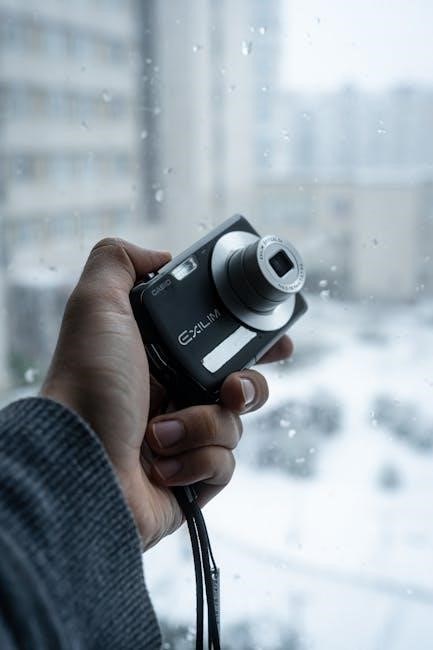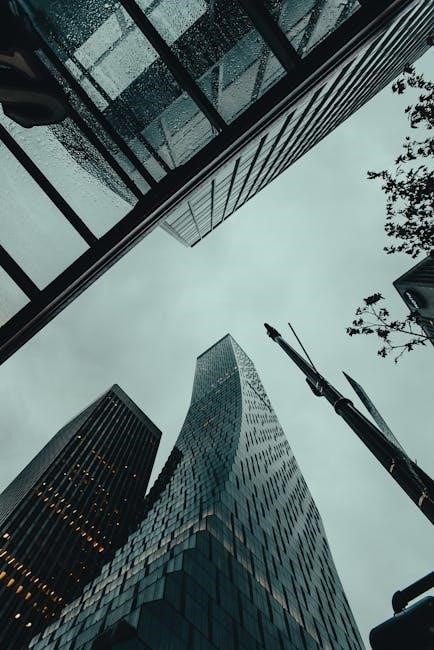The Seattle Stormwater Manual provides approved methods‚ criteria‚ details‚ and guidance for preventing contaminants from leaving a site. It helps implement Best Management Practices (BMPs) for source control‚ preventing pollutants from contaminating runoff.

Overview of the Seattle Stormwater Code
The Seattle Stormwater Code‚ found in Seattle Municipal Code (SMC) Chapters 22.800-22.808‚ contains regulatory requirements that promote public health‚ safety‚ and welfare. It aims to manage stormwater runoff effectively within the city limits of Seattle.
Regulatory Requirements and Objectives
The Seattle Stormwater Code outlines specific regulatory requirements designed to protect the environment and public health. These requirements aim to control the quantity and quality of stormwater runoff generated from development and redevelopment projects within the city. The code’s provisions are structured to accomplish several key objectives‚ including:
- Minimizing the discharge of pollutants into receiving waters such as rivers‚ lakes‚ and Puget Sound. This involves implementing source control BMPs to prevent pollutants from entering stormwater runoff in the first place‚ as well as treatment BMPs to remove pollutants from stormwater before it is discharged.
- Controlling the volume and flow rate of stormwater runoff to prevent erosion‚ flooding‚ and other adverse impacts on downstream properties and ecosystems. This is achieved through the use of flow control BMPs that detain or retain stormwater runoff‚ releasing it slowly over time.
- Protecting and restoring natural drainage systems‚ such as streams and wetlands‚ which play a vital role in stormwater management and provide important ecological functions. This involves minimizing impacts to these systems from development and promoting their restoration where feasible.
- Ensuring that stormwater management facilities are properly maintained to function as designed over the long term. This includes requirements for regular inspections‚ maintenance‚ and repairs.
- Promoting the use of green stormwater infrastructure (GSI) practices‚ such as rain gardens‚ green roofs‚ and permeable pavements‚ which can provide multiple benefits‚ including stormwater management‚ improved air quality‚ and enhanced urban aesthetics.
Compliance with the Seattle Stormwater Code is mandatory for all development and redevelopment projects that meet certain thresholds. The code is enforced by the Seattle Department of Construction and Inspections (SDCI) and Seattle Public Utilities (SPU)‚ which review and approve stormwater management plans and conduct inspections to ensure compliance.

Key Volumes and Appendices of the 2021 Manual
The 2021 Seattle Stormwater Manual is structured into several key volumes and appendices‚ each addressing specific aspects of stormwater management and providing detailed guidance for implementation. These volumes work together to provide a comprehensive framework for complying with the Seattle Stormwater Code and achieving its objectives.
- Volume 1: Project Minimum Requirements This volume outlines the minimum requirements that all development and redevelopment projects must meet to comply with the Stormwater Code. It covers topics such as site assessment‚ stormwater management planning‚ source control‚ flow control‚ and treatment. It also provides guidance on selecting appropriate BMPs for different site conditions and project types.
- Volume 2: Source Control Best Management Practices This volume provides detailed information on source control BMPs‚ which are designed to prevent pollutants from entering stormwater runoff in the first place. It covers a wide range of BMPs for different sources of pollution‚ such as vehicle fueling‚ waste management‚ and landscaping.
- Volume 3: Project Stormwater Control Best Management Practices This volume focuses on BMPs that are used to control the quantity and quality of stormwater runoff at project sites. It includes information on flow control BMPs‚ such as detention ponds and infiltration facilities‚ as well as treatment BMPs‚ such as bioretention and media filters.
- Volume 4: Construction Stormwater Control Best Management Practices This volume provides guidance on implementing BMPs to prevent erosion and sediment pollution during construction activities. It covers topics such as site stabilization‚ erosion control‚ and sediment control.
- Volume 5: Enforcement This volume details the enforcement provisions described in the Seattle Municipal Code (SMC) 22.800 ⎯ 22.808 (Stormwater Code).
In addition to the main volumes‚ the Stormwater Manual also includes a series of appendices that provide supplementary information and guidance. These appendices cover topics such as hydrologic modeling‚ flow control structure design‚ plant lists for bioretention facilities‚ and stormwater control operations and maintenance requirements. The appendices are an essential resource for designers‚ engineers‚ and other professionals involved in stormwater management.
The 2021 Seattle Stormwater Manual‚ along with its volumes and appendices‚ is available on the City of Seattle’s website in PDF format. It is important to consult the manual regularly to stay up-to-date on the latest requirements and guidance for stormwater management in Seattle.

Best Management Practices (BMPs) Implementation
Implementing Best Management Practices (BMPs) is crucial for effective stormwater management. The Seattle Stormwater Manual provides guidance on selecting and implementing appropriate BMPs for source control and project sites‚ ensuring compliance with regulations.
Source Control BMPs
Source control BMPs are designed to prevent pollutants from entering stormwater runoff at their origin. The Seattle Stormwater Manual provides comprehensive guidance on implementing these practices to minimize contamination. These BMPs are crucial for protecting receiving waters‚ such as rivers‚ lakes‚ and streams‚ by addressing potential pollutant sources before they impact stormwater quality.
Effective source control BMPs include measures to manage materials‚ prevent spills‚ and control erosion. Businesses‚ individuals‚ and public agencies in Seattle can utilize these BMPs to comply with the Seattle Stormwater Code and minimize the environmental impact of their activities. Proper implementation of source control BMPs is essential for maintaining water quality and protecting the health of the Puget Sound ecosystem.
The manual offers detailed information on various source control BMPs‚ including specific design criteria‚ maintenance requirements‚ and performance expectations. By following the guidelines outlined in the Seattle Stormwater Manual‚ stakeholders can effectively reduce pollutant loading in stormwater runoff and contribute to a cleaner‚ healthier environment. Regular inspection and maintenance of these BMPs are vital to ensure their continued effectiveness.
Furthermore‚ the manual emphasizes the importance of education and training to promote the proper implementation of source control BMPs. By increasing awareness and providing practical guidance‚ the Seattle Stormwater Manual empowers individuals and organizations to take proactive steps in preventing stormwater pollution. This collaborative approach is key to achieving long-term improvements in water quality throughout the city.
Project Site BMPs
Project Site BMPs‚ as detailed in the Seattle Stormwater Manual‚ are critical for managing stormwater runoff generated during construction and post-construction phases of development projects. These BMPs aim to minimize erosion‚ control sediment discharge‚ and treat stormwater to remove pollutants before it enters the city’s drainage system or natural water bodies. The Seattle Stormwater Code mandates the implementation of specific Project Site BMPs based on project size‚ location‚ and potential environmental impacts.
The manual provides extensive guidance on selecting‚ designing‚ and maintaining various Project Site BMPs‚ including temporary erosion and sediment control measures for construction sites and permanent stormwater management facilities for post-construction runoff. Examples of these BMPs include silt fences‚ sediment traps‚ detention ponds‚ biofiltration swales‚ and permeable pavements. Proper implementation of these BMPs is essential for complying with regulatory requirements and protecting water quality.
Furthermore‚ the Seattle Stormwater Manual emphasizes the importance of integrating Project Site BMPs into the overall site design to maximize their effectiveness and minimize their visual impact. This integrated approach considers factors such as site topography‚ soil conditions‚ and vegetation to optimize stormwater management while enhancing the aesthetic appeal of the project. Regular inspection and maintenance are crucial for ensuring the long-term performance of Project Site BMPs.
The manual also provides detailed information on specific design criteria‚ performance standards‚ and monitoring requirements for each type of Project Site BMP. By following these guidelines‚ developers and contractors can effectively manage stormwater runoff‚ reduce the risk of flooding‚ and protect the health of Seattle’s aquatic ecosystems. The Seattle Stormwater Manual serves as a valuable resource for ensuring that development projects are designed and constructed in a manner that minimizes their environmental impact.

Stormwater Control Operations and Maintenance
Stormwater Control Operations and Maintenance‚ as outlined in the Seattle Stormwater Manual‚ are crucial for ensuring the long-term functionality and effectiveness of stormwater management facilities; Proper operations and maintenance (O&M) prevent system failures‚ maintain design capacity‚ and protect water quality by ensuring that pollutants are removed from stormwater runoff. The Seattle Stormwater Code mandates regular inspection and maintenance of all stormwater control facilities to comply with regulatory requirements and protect the environment.
The Seattle Stormwater Manual provides detailed guidance on developing and implementing comprehensive O&M plans for various types of stormwater facilities‚ including detention ponds‚ biofiltration swales‚ and infiltration systems. These plans typically include scheduled inspections‚ routine maintenance tasks‚ and corrective actions to address any identified deficiencies. The frequency of inspections and maintenance activities depends on the type of facility‚ its location‚ and the potential for pollutant accumulation.
Routine maintenance tasks may include removing accumulated sediment and debris‚ mowing vegetation‚ repairing erosion damage‚ and clearing clogged inlets and outlets. Corrective actions may involve repairing structural components‚ replacing damaged vegetation‚ or retrofitting the facility to improve its performance. Proper documentation of all inspection and maintenance activities is essential for tracking the condition of the facility and identifying any recurring problems.
The Seattle Stormwater Manual also emphasizes the importance of training personnel responsible for O&M activities. Properly trained personnel are better equipped to identify potential problems‚ perform maintenance tasks effectively‚ and ensure that the facility is functioning as intended. The manual provides resources and guidance for developing training programs that cover topics such as stormwater regulations‚ facility design‚ inspection procedures‚ and maintenance techniques.
Furthermore‚ the Seattle Stormwater Manual highlights the need for long-term funding mechanisms to support ongoing O&M activities. Adequate funding is essential for ensuring that stormwater facilities are properly maintained throughout their lifespan. The manual provides information on various funding options‚ such as stormwater utility fees‚ dedicated maintenance funds‚ and grants. By prioritizing O&M‚ the City of Seattle can protect its investment in stormwater infrastructure and safeguard the health of its waterways.
